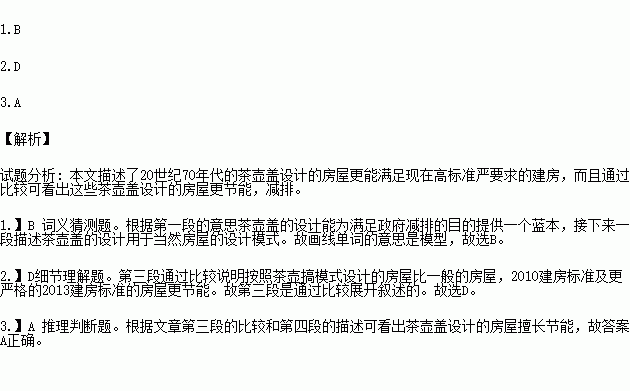题目内容
Not only fashion and music are making a return—houses built in 1970s have proven to be better at cutting energy waste than those built today. The “tea cosy (茶壶套)” design, created in the mid-1970s and built in the early 1980s for low-income people, could provide a blueprint for meeting the Government aims of producing less CO2 from homes.
The 200 houses were designed to provide low-energy housing, and depend on an inner concrete (水泥) structure that holds in heat, protected by highly insulated (隔热的) setting which produces a “tea cosy” effect. The ordinary-looking houses also depend on more windows on south-facing sides, with northerly facing doors protected by porches (门廊).
A study found the houses are 50 percent more energy efficient than the average home and use a quarter of the average energy for space heating. According to researchers, they use less than two-thirds of the power of homes built to meet 2010 building demands. And they will still be 25 percent more efficient than houses built to even more strict proposed demands for 2013. The design is one of the few that will be able to meet 2016 demands for zero-carbon homes.
They were in the beginning fixed with just one or two gas heaters per home, although most now have central heating, depending on the heat from the sun and high insulation to keep steady temperatures inside the house. To be comfortable, they only need to use heating for three to four months a year, compared with seven months for UK home on average, and can be lived with no heating at all.
With many house builders at present worrying that new homes are going to be much more expensive to build in order to meet the Government’s ambitious targets, the“tea cosy”model meets this need perfectly.
1.The underlined word“blueprint”is closest in meaning to _________.
A. photo B. model C. service D. map
2.The writer develops Paragraph 3 mainly by_________.
A. analyzing data
B. giving examples
C. presenting reasons
D. making comparisons
3.According to the passage, “tea cosy” houses are better at __________.
A. saving heat for energy efficiency
B. producing solar energy at home
C. designing and building materials
D. saving building materials and energy

